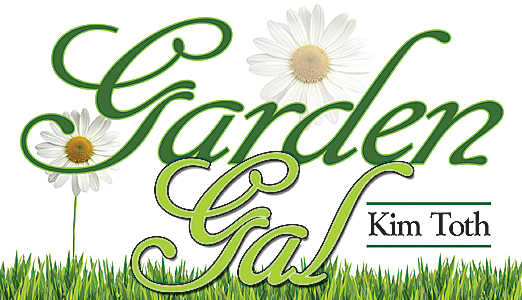Thursday, November 6, 2008
And What to My Wandering Eyes Should Appear?
"Life finds a way" - actor Jeff Goldblum, from the film Jurassic Park.
Early this morning I went out back with the dogs for their morning ritual. Sometimes I have to stay out with them or they'll just turn around and follow me back inside. So as I wandered around the patio, I walked over to my secondary water feature, which we call "the fountain."
I'm sure I've mentioned it before. It's just a 20-gallon circular liner sunk into a triangular-shaped flower bed off the patio. It was my "starter water garden." I added it to see if I could be bothered to take care of a fish pond. Obviously it was a success, since I now have a 240-gal. pond with too many fish!
In the summer of 2007 we had a population explosion and doubled our fish. I had 15 and now there are well over 30! The big white fish we suspected to be the birth mother died earlier this summer and I prayed for no more babies. Fortunately, none arrived, at least I didn't think so ...
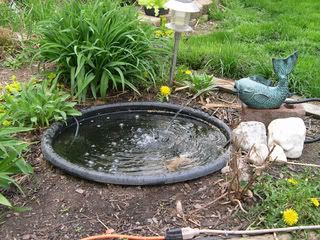
Back to this morning ... I looked down into the fountain, frowning over all the leaves that have collected in it over the last couple weeks ... and that's when I saw something move!
I usually expect to see at least one startled frog dive suddenly to the depths, but this was not that! I squinted and looked closer - yes, it was a tiny little white fish, only about 3/4 of an inch in size. And as I looked at it, amazed, another, quite larger black fish swam past (about 2 inches)!
And then there was another and another. Four total that I could see, all darting under the floating hyacinths that still linger in the fountain. Great!
How does this happen, when there are no other fish in the fountain? I'm as amazed as you are, but I think it has to do with the hyacinths. You see, they multiply at a fast rate (and are outlawed in some parks because, if left on their own, they will choke the life out of a water source). Anyway, all summer long I'm constantly throwing them out and I usually move some from the pond to the fountain, to keep it from getting green with algae. The floating plants block the sunlight, which counteracts the growth of the algae. Somewhere during this process, I think, the baby fish/eggs are in the feathery roots that hang from these plants and are thus transferred with the plant to the fountain.
So this weekend as I go about draining the fountain and covering it for the winter (I've found that if I don't, the frogs will choose to winter-over there and will die when the fountain freezes - yes, it's happened, that's why I cover it), I'll have to try to catch these babies in a small net and transfer them to the bigger pond. You'd be surprised how quick they are!
Oh well, such is life.
Labels: newborn fish, pond fish, water gardening, water hyacinths
Thursday, October 23, 2008
Winter Water Gardening Tips
Here's just a little something that I got from the National Home Gardening for all your water gardening enthusiasts on preparing your aquatic garden for winter.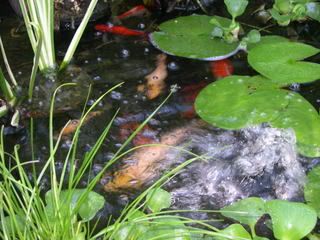 When frost starts nipping at your garden, it's time to think about winterizing ponds and other water features. The experts at TetraPond offer the following tips:
When frost starts nipping at your garden, it's time to think about winterizing ponds and other water features. The experts at TetraPond offer the following tips:
Cut back lilies and other deep-water plants to 1 inch above the tip. Replace soil and gravel, as needed.
Move plants to deeper water if you live in a climate where ponds freeze.
Cut back all growth on bog plants surrounding your pond and mulch with 6 inches of straw.
Place tender floating plants like water hyacinth in a 3-inch water-filled tray and move them to a frost-free shed or greenhouse. (This is a new one for me, I never thought about saving my hyacinths, maybe I'll give it a try.)
When temperatures drop and fish spend most of their time on the bottom of the pond, stop feeding them.
Clean out leaves and twigs that fall into the pond and remove as much duckweed as possible.
Use a de-icer to keep a small area of the pond ice-free. This helps fish survive by creating a spot for harmful gasses to escape.
Turn off filters, then clean them and store them inside.
Spend the time now to keep your water features happy and healthy—so when spring comes, you'll be ready! Looks like I've got my work cut out for me this weekend ...Labels: duckweed, pond fish, Tetra Pond, water gardening, water hyacinths, winter tips
Monday, October 20, 2008
Autumn chores
Hi everybody, sorry to leave you all hanging for so long, but I've been recuperating from all the cuts I received a week ago, while tying up my ornamental grasses!
Not really, but I did manage to get quite a few cuts, doing this and other weekend chores. You see, I remembered to wear protective gloves while tying up the grasses. However, I did not remember to wear long sleeves! So I must stress to the rest of you, if you're planning to tie up your grasses, rather than cutting them back for the winter, make sure you wear proper protection. The fine blades of the grass can wreak havoc on your skin. And while it doesn't sound that bad, imagine 20-30 little paper cuts all up and down your arms!
Anyway, I choose to tie up my grasses rather than cut them back. Either option will not harm the grasses in any way (it's pretty difficult to kill grass). I like the way they look throughout the fall and into the winter. And as I've stated before, in the spring when I do cut them back, I save the cuttings, tie them together, store them in the shed and viola, come fall I have unique decorations for the front of my house.
As pictured here, they are a economical/ecological way to decorate, instead of buying corn husks. 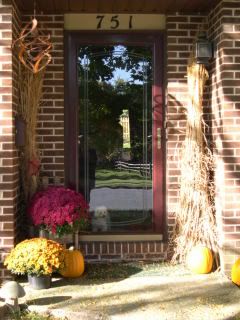
Over this past weekend, I managed to get a few things on my To Do list done. Like cleaning up the leaves on the patio - this has become a regular chore over the last month. It seems like the dynamics of my patio make for a perfect gathering place for leaves ... so every weekend I go out with my handy-dandy Black & Decker leaf machine and suck them up. With three dogs, I get plenty of leaves inside the house as well, and it all goes into the compost pile with grass clippings from the lawn. The combination of green matter and brown matter makes for a good base for next year's compost. (Of course, I'm still hoping for a good yield of compost, after failing miserably the last two seasons.)
And the leaves don't just end up on the patio ... the pond is full of them too. So Saturday it was time to get the net out! I hate getting the net out, it's my last admission of defeat (that the summer's really over), but it had to be done or the fish wouldn't have any room to swim! Anyway, in preparation for covering the pond, the summer pond plants had to be removed as well. So that means the canna and black taro got taken out to die back from the cold nights, and then placed in the basement to hibernate till next year. The net tends to confuse the frogs too. 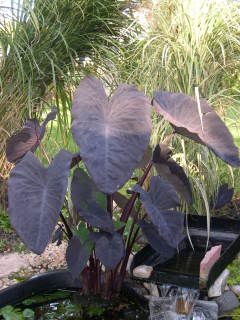 Black TaroAnd since my neighbors have left for their winter home in Florida and covered their pond already, I have more frogs to tend to. So I can't completely cover my pond, or the frogs wouldn't be able to get in or out. It usually takes a couple of days to figure out exactly where they are comfortable jumping in/out, so I can leave that end a little open. Every now and then over the years, I find a frog early in the morning sitting in the middle of the net, confused, cold and in need of rescue!
Black TaroAnd since my neighbors have left for their winter home in Florida and covered their pond already, I have more frogs to tend to. So I can't completely cover my pond, or the frogs wouldn't be able to get in or out. It usually takes a couple of days to figure out exactly where they are comfortable jumping in/out, so I can leave that end a little open. Every now and then over the years, I find a frog early in the morning sitting in the middle of the net, confused, cold and in need of rescue!
Still have to plant the dward rhododendrons my previous neighbors left me when they moved a couple months ago ... time's running out. And I still haven't planted my precious Allium bulbs yet. If you still have any perennials, bulbs or shrubs left to plant, get them in the ground ASAP. Especially since last night we actually had frost.
And most important (because I've been forgetting this one too) WATER! This month's lack of rain has not been kind to our plant life. Especially for any new plantings, get out and water! Just because summer flowering season is over, don't forget your plants still need water ... I can't stress this enough. Water early in the day, if possible, since the temperature has been dipping at night, it's not a good idea to wait until near dusk to water. You wouldn't want to be out there at night all wet ... Labels: backyard ponds, black taro, bulbs, canna, frogs, ornamental grasses, perennials, pond fish, water gardening
Monday, June 2, 2008
R.I.P. Brangelina
No, not THAT Brangelina – my Brangelina. If you’re a regular reader of my blog, you remember that I’ve been referring to my "very pregnant" fish as "Brangelina."
Sadly, my Brangelina was belly-up between two pond plants Friday night after I got home from work. I guess she wasn’t pregnant afterall. She was one of my original pond fish, purchased five years ago from Caccoosing Creek Ponds and Landscaping on the other side of Sinking Spring. She was also one of my bigger fish measuring well over 10 inches from nose to tail. A mostly white "red comet," she had become severely bloated towards her tail over the last month (suggesting that she was going to lay eggs).
For the past two weeks, she hovered along the bottom of the pond, lethargic to say the least. We thought this was part of the normal process before a fish lays eggs. Maybe she was pregnant and something happened for the worse. Anyway, I like to think she had a good life. As best as we could make it anyway.
We’ve been very fortunate with our fish, she was only the third we’ve lost so far. And since everyone else seems healthy, we hope that she didn’t die from anything contagious.
Yes, I know, it’s only a fish, and although we enjoy our pond and it’s wildlife very much, it’s not the same as losing a dog, cat or other beloved pet. But the fish have come to be part of our lives too. We feed them, clean the filter, sometimes add a little ice to the water when the temp gets too warm. We even cut up oranges last year and threw them into the pond for a treat that they seemed to enjoy.
There are too many to name, but some have characteristics and/or colors that have separated them from the rest of the school. Our biggest fish is a huge white "whale" of a goldfish with a little red spot on its nose – hence the name "Moby." Then there’s "Red" the biggest of our Red Comets, almost as big as Moby. Copper, a beautiful mostly black Shebunkin, gets its name from the copper coloring splashed across its body.
Also, Nemo, the first baby ever to survive in our pond. Nemo, who’ll be two years old this summer, is almost seven inches from nose to tail and white with orange/gold spritzes throughout. Frosty, the tiny baby fish (only about 1 ½ inches) who was born, surprisingly, sometime over the winter, is all white and still teeny. And our newest "named" fish is one of last year’s babies – a completely black/grey fish who we can hardly ever see, accept when it comes to the top to get food – the Phantom.
A quick check of www.aquariumfish.com states that the average life span of pond goldfish is well over 10 years, assuring us that, pending any unfortunate disease, we should have our fish for quite a while to come. And if this year’s anything like last summer, we’ll have plenty more. Yikes!
Coming this week I’ll tell you all about those Earth Boxes, the Perennial of the Year, the Bubbler and the truth about Solar Lights.Labels: goldfish, pond fish, red comets, shebunkins

 RSS
RSS
